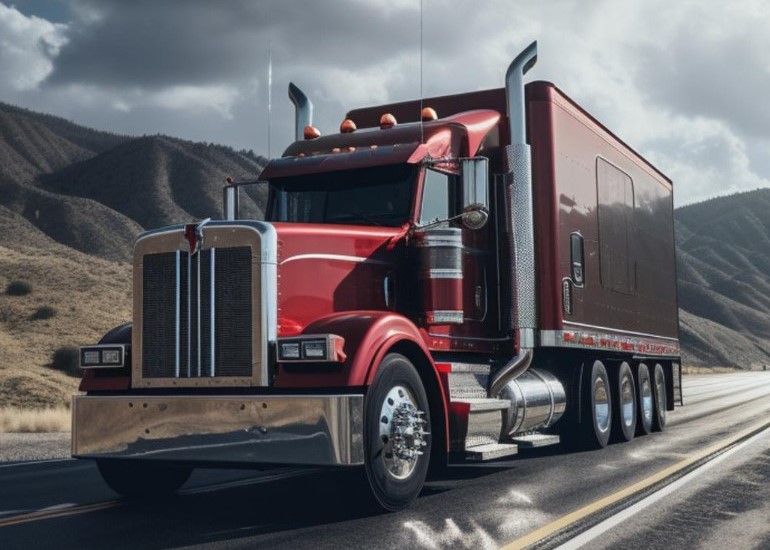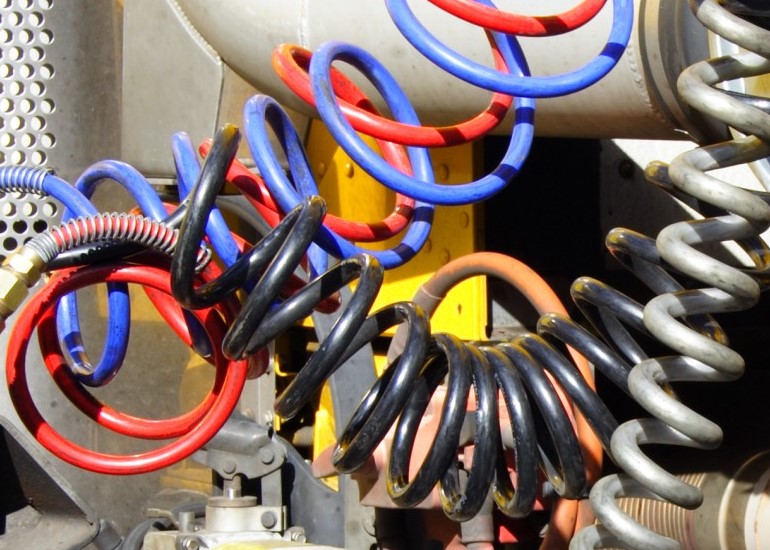Online CDL Permit Practice Tests
state Oregon
Ace Your Oregon CDL Exam: Free Practice Tests
Don't waste your time - start practicing with free online tests today
Our free online CDL practice tests cover all the essential topics, including General Knowledge, Air Brakes, and Combination Vehicles. Practice at your own pace, anytime, anywhere, to build your confidence and ensure you’re fully prepared for your CDL exam.
General Knowledge Test
Air Brakes
Test
Combination Vehicle Test
Step-by-Step Guide to Getting a CDL in Oregon
Step 1: Determine Your CDL Class and Endorsements
Before pursuing a Commercial Driver License (CDL) in Oregon, it’s essential to identify the appropriate license class and any necessary endorsements based on the type of commercial vehicle you intend to operate.
CDL Classes in Oregon
Oregon issues three classes of CDLs:
Class A: Permits operation of any combination of vehicles with a Gross Combination Weight Rating (GCWR) exceeding 26,000 pounds, provided the Gross Vehicle Weight Rating (GVWR) of the towed vehicle exceeds 10,000 pounds. This class also allows operation of all vehicles under Classes B and C, subject to appropriate endorsements.
Class B: Authorizes operation of a single vehicle with a GVWR exceeding 26,000 pounds, or any such vehicle towing a vehicle not exceeding 10,000 pounds GVWR. It also covers vehicles under Class C, with necessary endorsements.
Class C: Allows operation of vehicles designed to transport 16 or more passengers (including the driver) or vehicles used to transport hazardous materials, provided the GVWR is less than 26,001 pounds.
CDL Endorsements
Depending on the specific vehicle type or cargo, additional endorsements may be required:
Double/Triple Trailers (T): Required to operate vehicles pulling double or triple trailers. Prerequisites include holding or qualifying for a Class A CDL and passing the Doubles and Triples Endorsement Knowledge Test.
Hazardous Materials (H): Necessary for transporting hazardous materials. Requirements include passing the Hazardous Materials Endorsement Knowledge Test, undergoing a Transportation Security Administration (TSA) background check, and completing Entry-Level Driver Training if obtaining this endorsement for the first time.
Tank Vehicles (N): Required for operating vehicles designed to transport liquids or gases in bulk containers.
Passenger Transport (P): Mandatory for drivers operating vehicles designed to carry 16 or more passengers, including the driver.
School Bus (S): Specifically for operating school buses.
Restrictions
Certain restrictions may be applied to a CDL based on the vehicle used during testing or specific driver qualifications:
Air Brake Restriction: If an applicant does not pass the air brakes knowledge test or performs the skills test in a vehicle without air brakes, a restriction will be placed on the CDL prohibiting the operation of vehicles with air brakes. To remove this restriction, the driver must pass the air brakes knowledge test and the skills test in a vehicle equipped with air brakes.
Manual Transmission Restriction: If the skills test is taken in a vehicle with an automatic transmission, a restriction will be placed on the CDL limiting the driver to operating automatic transmission commercial vehicles. Removing this restriction requires passing the skills test in a vehicle with a manual transmission.
Understanding these classifications, endorsements, and restrictions is crucial for determining the specific requirements applicable to your intended commercial driving activities in Oregon.
Step 2: Obtain a Commercial Learner's Permit (CLP):
Acquiring a Commercial Learner’s Permit (CLP) is a crucial step toward obtaining a Commercial Driver License (CDL) in Oregon. The CLP allows you to practice driving commercial vehicles under supervision, preparing you for the CDL skills test.
Eligibility Requirements
To apply for a CLP in Oregon, you must:
Age: Be at least 18 years old for intrastate driving (within Oregon) or 21 years old for interstate driving (across state lines) or transporting hazardous materials.
Driver’s License: Hold a valid Oregon Class C (non-commercial) driver’s license.
Driving Experience: Have at least one year of driving experience in a non-commercial Class C vehicle.
Medical Certification: Obtain a Medical Examiner’s Certificate from an examiner listed in the National Registry of Certified Medical Examiners. This certificate must be submitted to the Oregon DMV.
Application Process
Documentation: Gather the necessary documents to prove your full legal name, lawful status in the U.S., identity, date of birth, and Oregon residence address. You will also need to provide your Social Security Number on the application.
Knowledge Tests: Pass the required knowledge tests, which may include:
General Knowledge Test: Mandatory for all CLP applicants.
Combination Vehicle Knowledge Test: Required for Class A CLP applicants.
Air Brake Knowledge Test: Necessary if you intend to operate vehicles equipped with air brakes.
Endorsement Tests: If you plan to operate specific types of vehicles or carry particular cargo (e.g., hazardous materials, passengers), additional tests may be required.
Vision Screening: Pass a vision screening to ensure you meet the visual standards for commercial driving.
Application Submission: Submit your application, along with all required documentation and test results, to an Oregon DMV office.
Fees: Pay the applicable fees for the CLP application and any endorsement tests.
CLP Validity and Use
Validity Period: The CLP is valid for one year.
Holding Period: You must hold the CLP for at least 14 days before you are eligible to take the CDL skills test.
Supervised Driving: While operating a commercial vehicle with a CLP, you must be accompanied by a person who is at least 21 years old, holds a valid CDL for the type of vehicle being driven, and occupies the seat beside you.
Restrictions While Holding a CLP
With a CLP, you are prohibited from:
Transporting hazardous materials.
Operating double or triple trailers.
Driving passenger vehicles while transporting passengers (except for necessary training purposes).
Operating tank vehicles unless the tank is empty.
By fulfilling these requirements and adhering to the outlined restrictions, you will be well-prepared to progress toward obtaining your CDL in Oregon.
Step 3: Complete Entry-Level Driver Training (ELDT):
As of February 7, 2022, individuals seeking to obtain a Commercial Driver License (CDL) in Oregon must complete Entry-Level Driver Training (ELDT) before taking the CDL skills test. This training ensures that new drivers possess the necessary knowledge and skills for safe operation of commercial motor vehicles.
Who Needs to Complete ELDT
ELDT is required for individuals who are:
Obtaining a Class A or Class B CDL for the first time.
Upgrading an existing Class B CDL to a Class A CDL.
Obtaining a passenger (P), school bus (S), or hazardous materials (H) endorsement for the first time.
Those who held a valid CDL or the specified endorsements before February 7, 2022, are exempt from this requirement.
Training Components
ELDT comprises two main components:
Theory Instruction: This includes classroom or online education covering topics such as vehicle operation, safety protocols, and regulatory compliance.
Behind-the-Wheel (BTW) Training: Practical, hands-on driving experience conducted on a range or public roads, focusing on vehicle control and real-world driving scenarios.
Both components must be completed successfully to meet ELDT requirements.
Approved Training Providers
Training must be obtained from a provider listed on the Federal Motor Carrier Safety Administration’s (FMCSA) Training Provider Registry (TPR). In Oregon, various institutions offer ELDT programs. To find an approved provider, consult the TPR.
Exemptions
You may be exempt from ELDT if:
You were issued an Oregon Commercial Learner’s Permit (CLP) before February 7, 2022, and obtain your CDL before the CLP expires.
You have previously held a Class A or B CDL, or the specified endorsements.
You have received a Military CDL skills test waiver.
For detailed exemption criteria, refer to the Oregon Department of Transportation’s guidelines.
Verification and Compliance
Upon completing ELDT, the training provider will submit your certification to the TPR. The Oregon Department of Motor Vehicles (DMV) will verify this information before allowing you to proceed with the CDL skills test or the hazardous materials endorsement knowledge test.
By fulfilling the ELDT requirements through an approved provider, you ensure compliance with federal and state regulations, paving the way for a successful career as a commercial driver in Oregon.
Step 4: Practice with Your CLP:
After obtaining your Commercial Learner’s Permit (CLP) in Oregon, it’s essential to gain practical experience to prepare for the Commercial Driver License (CDL) skills test. The CLP allows you to operate a commercial motor vehicle (CMV) under specific conditions, facilitating hands-on learning.
Supervised Driving Requirements
While practicing with a CLP, you must adhere to the following conditions:
Qualified Supervisor: A valid CDL holder, qualified for the type of vehicle you are operating, must accompany you. This supervisor must occupy the front passenger seat to provide immediate assistance and instruction.
Vehicle Class Consistency: Practice should occur in the class of vehicle corresponding to your intended CDL class, ensuring relevant experience.
Practice Restrictions
Certain limitations apply when operating a CMV with a CLP:
Passenger Transport: You are prohibited from transporting passengers, except for the supervising CDL holder and other trainees.
Hazardous Materials: Operating vehicles transporting hazardous materials, as defined by federal regulations, is not permitted.
Double/Triple Trailers: You may not operate vehicles towing double or triple trailers.
Tank Vehicles: Operating tank vehicles is restricted unless the tank is empty and purged of hazardous materials.
Practice Recommendations
To maximize the benefits of your practice sessions:
Structured Training: Enroll in a reputable training program that offers structured behind-the-wheel instruction, ensuring comprehensive skill development.
Diverse Driving Conditions: Practice in various traffic conditions, terrains, and weather scenarios to build adaptability and confidence.
Vehicle Maneuvers: Focus on essential maneuvers such as backing, turning, parking, and coupling/uncoupling trailers, as these are critical components of the CDL skills test.
Documentation and Compliance
Maintain accurate records of your practice hours and driving experiences. Adhering to all state and federal regulations during your practice sessions is crucial for legal compliance and safety.
By diligently practicing under these guidelines, you will enhance your driving proficiency and readiness for the CDL skills test, paving the way for a successful career in commercial driving.
Step 5: Schedule and Pass the CDL Skills Test:
After holding your Commercial Learner’s Permit (CLP) for at least 14 days and completing the required Entry-Level Driver Training (ELDT), you are eligible to take the Commercial Driver License (CDL) skills test in Oregon. This test evaluates your ability to operate a commercial motor vehicle (CMV) safely and competently.
Scheduling the CDL Skills Test
In Oregon, CDL skills tests are conducted by certified third-party testing businesses authorized by the Oregon Driver & Motor Vehicle Services (DMV). To schedule your test:
Choose a Testing Provider: Select an approved third-party tester from the list provided by the Oregon DMV. These businesses offer flexible scheduling options, including evenings and weekends. For example, NW Drivers Ed, LLC offers Class C drive tests with convenient scheduling.
Contact the Provider: Reach out directly to your chosen testing business to schedule your skills test. Be prepared to provide your Oregon DMV customer number, which can be found on your instruction permit, ID card, or knowledge test receipt.
Confirm Appointment Details: Discuss the test location, fees, vehicle requirements, and any necessary documentation with the testing provider. Ensure you understand their specific policies regarding cancellations or rescheduling.
Preparing for the CDL Skills Test
The CDL skills test comprises three main components:
Pre-Trip Vehicle Inspection: Demonstrate your ability to assess the safety and readiness of your vehicle. This includes checking critical components such as brakes, lights, and steering mechanisms.
Basic Control Skills Test: Show proficiency in controlling the vehicle through maneuvers like backing, parking, and turning within a confined area.
On-Road Driving Test: Operate the vehicle in various traffic situations to exhibit safe driving practices, adherence to traffic laws, and proper handling of the CMV.
Test Day Requirements
On the day of your test:
Documentation: Bring your valid Oregon driver’s license, CLP, Medical Examiner’s Certificate, and any other required documents.
Vehicle Provision: Provide a CMV that matches the class of license you are seeking. The vehicle must be in safe operating condition, have current registration and insurance, and be unloaded. Some testing providers may offer vehicle rental options.
Arrival Time: Arrive promptly at the scheduled time. Late arrivals may result in the need to reschedule and could incur additional fees.
Fees and Payment
Testing fees vary by provider and may depend on factors such as location and vehicle rental. For instance, Hanford Testing Services charges $250 for the CDL skills test, with a potential $50 travel fee. Payment is typically required at the time of scheduling. Be sure to inquire about accepted payment methods and any cancellation policies.
After the Test
Successful Completion: If you pass all components, the examiner will provide documentation to present at the DMV for CDL issuance.
Retesting: If you do not pass, you must wait a minimum period before retesting. Discuss retest procedures and any additional training recommendations with your examiner.
By thoroughly preparing and understanding the testing process, you can approach the CDL skills test with confidence and take a significant step toward your career as a commercial driver in Oregon.
Step 6: Obtain Your CDL:
After successfully passing the CDL skills test, the final step is to obtain your Commercial Driver License (CDL) from the Oregon Driver & Motor Vehicle Services (DMV).
Post-Test Procedures
Waiting Period: You must wait at least one business day after passing your CDL skills test before visiting a DMV office to obtain your CDL.
Documentation: Ensure you have all necessary documents, including your valid Oregon driver’s license, Commercial Learner’s Permit (CLP), Medical Examiner’s Certificate, and the skills test completion certificate provided by the examiner.
Visit the DMV Office
Application Submission: Present your documents and complete any required application forms at the DMV office.
Vision Screening: Undergo a vision screening as part of the final licensing process.
Fee Payment: Pay the applicable fees for CDL issuance. For current fee information, refer to the Oregon DMV’s fee schedule.
License Issuance
Photo Capture: Your photograph will be taken for the CDL.
License Delivery: The DMV will issue your CDL, marking the culmination of your training and testing process.
By completing these steps, you will have successfully obtained your Commercial Driver License in Oregon, enabling you to pursue professional opportunities in commercial driving.
Additional Considerations:
When pursuing a Commercial Driver License (CDL) in Oregon, it’s important to be aware of several key factors that can influence your eligibility and the scope of your driving privileges.
Medical Certification Requirements
All CDL applicants must undergo a Department of Transportation (DOT) medical examination conducted by a certified Medical Examiner listed on the National Registry of Certified Medical Examiners. This examination ensures you meet the physical qualifications necessary for safe operation of a commercial motor vehicle. The resulting Medical Examiner’s Certificate must be submitted to the Oregon Driver and Motor Vehicle Services (DMV) and maintained with a valid, unexpired status. Failure to keep this certification current may lead to the cancellation of your CDL.
Self-Certification of Driving Type
Oregon requires CDL holders to self-certify their type of driving based on the nature of their commerce:
Non-Excepted Interstate: Operating across state lines or transporting goods that originate or terminate outside Oregon.
Excepted Interstate: Engaging in interstate commerce but exempt from certain federal requirements.
Non-Excepted Intrastate: Operating solely within Oregon without exemptions.
Excepted Intrastate: Conducting intrastate commerce with specific exemptions.
Most drivers opt for Non-Excepted Interstate status to maintain broader driving privileges. Selecting the appropriate category is crucial, as it determines medical certification requirements and may affect your CDL’s validity.
Endorsements and Restrictions
Depending on the vehicles you intend to operate and the cargo you plan to transport, additional endorsements may be necessary. These endorsements often require passing specialized knowledge and skills tests. Conversely, certain restrictions might be placed on your CDL based on the vehicle used during testing or specific qualifications. For instance, if you test in a vehicle without air brakes, a restriction will prohibit you from operating vehicles equipped with them. Understanding these endorsements and restrictions is vital to ensure your CDL aligns with your intended driving activities.
By thoroughly considering these factors and adhering to Oregon’s regulations, you can navigate the CDL acquisition process more effectively and embark on a successful commercial driving career.
Frequently asked questions
Who needs a Commercial Driver License (CDL) in Oregon?
Anyone who operates a commercial motor vehicle with a gross vehicle weight rating (GVWR) of 26,001 pounds or more, transports hazardous materials that require placarding, or drives a vehicle designed to transport 16 or more passengers, including the driver, is required to hold a CDL.
What are the age requirements to get a CDL in Oregon?
You must be at least 18 years old to apply for a CDL in Oregon for intrastate (within the state) driving. To operate commercial vehicles across state lines (interstate), transport passengers, or carry hazardous materials, you must be at least 21 years old.
Do I need a regular driver's license before applying for a CDL?
Yes, you must already hold a valid non-commercial Oregon driver license (Class C) before applying for a Commercial Learner’s Permit (CLP), which is the first step toward obtaining a CDL.
What is the purpose of the Commercial Learner’s Permit (CLP)?
The CLP allows you to practice driving a commercial vehicle under the supervision of a qualified CDL holder. You must hold a CLP for at least 14 days before you can take the CDL skills test.
Is Entry-Level Driver Training (ELDT) required in Oregon?
Yes, ELDT is required for first-time applicants of Class A or Class B CDLs, upgrades from Class B to Class A, and for those applying for a school bus (S), passenger (P), or hazardous materials (H) endorsement for the first time. Training must be completed with an FMCSA-approved provider.
What tests do I need to take to get a CDL in Oregon?
You must pass a general knowledge written test, any applicable endorsement knowledge tests, and a three-part CDL skills test, which includes a pre-trip inspection, basic vehicle control, and an on-road driving portion.
What vehicles can I use for the CDL skills test?
You must provide your own vehicle that matches the class of CDL you are testing for. The vehicle must be safe, properly registered, and have the features necessary to avoid restrictions on your license, such as air brakes or manual transmission.
Are there restrictions placed on the CDL if I test in certain vehicles?
Yes, if you take the skills test in a vehicle with automatic transmission or without air brakes, your CDL will include restrictions that prevent you from operating manual transmission vehicles or those equipped with air brakes.
What medical requirements must I meet for a CDL in Oregon?
You must pass a DOT medical exam performed by a certified medical examiner and submit your Medical Examiner’s Certificate to the Oregon DMV. The certificate must be kept current to avoid suspension or downgrade of your CDL.
How long is a CDL valid in Oregon and how do I renew it?
A CDL in Oregon is typically valid for eight years. To renew, you must complete the application, present required identification, pay the renewal fee, and ensure your medical certification is up to date if required.



